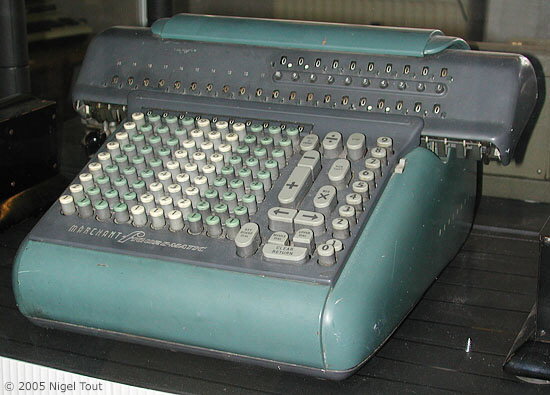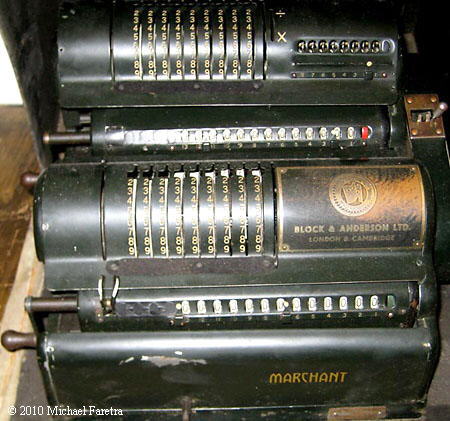

Notes on Monroe and Marchant Calculators
by Nicholas Bodley (© 1996)

editor's note: Nicholas is a former employee of several of the early mechanical/electro-mechanical calculator makers and considers himself a "lover of small precision mechanisms." We appreciate his insight into the early days of "modern calculating."
MONROE
The author worked for a competitor to Monroe, so this is rather spotty knowledge. Monroe Calculating Machine Company (?) was based, I believe, in Orange, N. J., or some other northern community in that state. It dates back perhaps to the early 1920s, possibly before. Its first models were probably driven by a handcrank on the right side of the "wedge" I have described for the electrically-driven machines. (Their basic design was essentially the same.)
Their first models might not have had the explicit "wedge and carriage" design I have described; late 19th-century and early 20th-century calculators had outer shapes much more distinctive and more closely related to their internal mechanisms, and the first Monroes might have looked similar.
An earlier Monroe had an external drive motor, and was physically rather large; it took up as much desk space as a large typewriter. I owned one, for a while; it was lost in a burglary. Like all Monroes, the main driveshaft turned clockwise (looking at the right side of the machine) to add, and counterclockwise to subtract. This machine required manual shifting and watching the dials to do multiplication and division. It had a removable cover with a knob that allowed you to insert a handcrank (after unplugging the drive motor, I daresay!)
Later Monroes were "miniature" versions of this larger, older basic design, and had internal drive motors. These calculators were light in weight and quite compact, as small as reasonable; their internal parts were quite possibly simply scaled-down versions of the earlier larger parts, with minimal detail changes. Monroes of the later era were relatively sophisticated compared to typical Fridens (although only Fridens did square root, I'm fairly sure). However, they weren't as rugged as Fridens. My recollection is that different models offered quite a variety of levels of automation; some didn't multiply automatically, I believe.
Multiplying on the machines with automatic multiplication (which must have been the majority of those sold) used the main keyboard to enter both operands; I do not know anything about the mechanism that stored the multiplier.
Most Monroes were, I'm fairly sure, either 10-digit or possibly 8-digit machines, with all digits of a maximum product displayed.
To my knowledge, Monroe did not develop its own electronic calculator; I might have forgotten! Perhaps I simply didn't become aware of it. [The Monroe Epic 3000 electronic calculator is featured on this site.]
Probably the pinnacle of mechanical calculator design was the Monroe PC-1421. This was a remarkable machine, with modular construction that made maintenance much easier; it used quite-small molded plastic parts, which meant minimal inertia (a significant problem in mechanical calculators). It was a printer, with completely automatic decimal points; it could accept a 14-digit number via a 10-key serial-entry keyboard, and could print 21-place results. Some day, I hope to see its insides!
MARCHANT
These remarks are rather sketchy; the author worked for a competitor. Marchant started early in the 20th century, and possibly even earlier. Its first machines probably looked in general like the earlier European and late 19-century machines; these were probably mostly or all hand-operated. I know very little about them.
I believe they made some electrically-driven machines earlier in the century, which used the "stepped reckoner" principle, or else the principle of a gear with individually-movable teeth that effectively could act as anything from a zero to a nine- (or ten)-tooth gear. (The teeth moved radially.)
Later in the company's history, probably somewhere between the late 1930s and 1945, Marchant brought out an electrically-driven machine with the same basic "carriage on top of a wedge" design, with rounded-corner and streamlined styling, colored in green and blue. Its internal mechanism was a dramatically-different, quite sophisticated, and more-complicated design compared to any others I know about.
It was over twice as fast as its competitors; so fast, in fact, that you could enter the digits of a multiplier serially on a row of keys along the right edge; even a nine was accumulated so fast that the time required was quite acceptable. I'm fairly sure its rated speed was 1,300 cycles per minute. Other electrically-driven machines ran typically at 600 cycles per minute.
This design was called "proportional gears"; each digit of the main keyboard had its own tiny 9-speed transmission (in the automotive sense); carries in the accumulator were done by 10:1 gear reductions, and each of the 20 accumulator dials (except the rightmost) had two differentials! (One added in the numbers from the little transmissions; the other realigned the dials.) That's a total of 39 differentials...
While accumulating a product of 2 or greater during multiplication, almost all parts of the machine were rotating at constant speeds; this was unique to Marchant. (The same happened if you held down the + bar; the relative quiet was quite impressive.)
By comparison, all other makes required the accumulator dials to start and stop, both for "digitation" and for carries. ("Digitation" is the process of updating the contents of the accumulator by transferring into it the number in the main keyboard's mechanism; it occurs before carries are entered into the accumulator.)
A Marchant Figurematic. A highly capable electrically powered mechanical calculator.

Marchant also made a calculator called the "Twin Marchant", which I know little about; there might even have been two quite-different special machines built. One account has it that two (earlier-design) Marchants were placed closer to and farther away from the operator, and possibly coupled mechanically somehow; the other possibility is that of a huge machine, possibly capable of multiplying two 20-digit numbers and displaying a 40-place product. The author would welcome more information on these! A good Web search is in order. [See below.]
Marchant is also said to have made a (mechanical) so-called "binary-octal" (?) version; apparently this was a radix-8 (octal, or octonary) machine. Again, the author knows very little about this. It does sound practical, although the tooling costs would have been substantial.
Not long after Friden announced its EC-130 electronic desktop calculator, Marchant brought out its Cogito, which was similar to the Friden; the author's recollection is that it was physically smaller. It had peculiar-looking half-size zeros.
Additional information about the Twin Marchant
Since Nicholas Bodley wrote the above article further information has come to light about the Twin Marchant. The story is told in this section in "The Twin Marchant and its place in history".

Close up of a Twin Marchant.
See also the page on Marchant in the Calculator Manufacturers section.
Calculator Articles
Vintage Calculators
Text & photographs copyright, except where stated otherwise, © Nigel Tout 2000-2025.